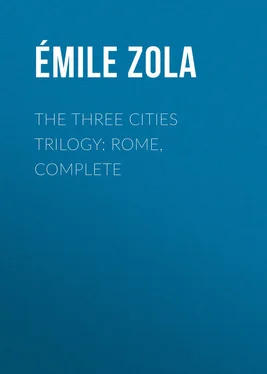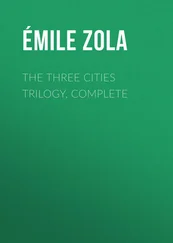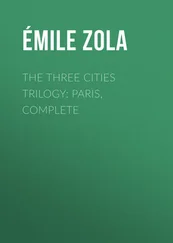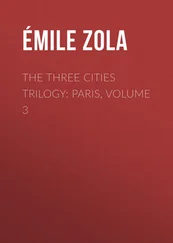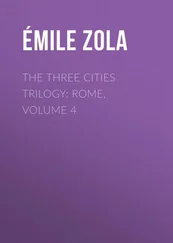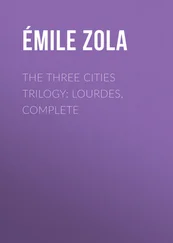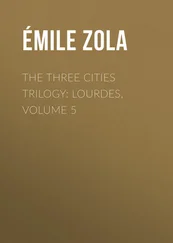Émile Zola - The Three Cities Trilogy - Rome, Complete
Здесь есть возможность читать онлайн «Émile Zola - The Three Cities Trilogy - Rome, Complete» — ознакомительный отрывок электронной книги совершенно бесплатно, а после прочтения отрывка купить полную версию. В некоторых случаях можно слушать аудио, скачать через торрент в формате fb2 и присутствует краткое содержание. Жанр: literature_19, foreign_antique, foreign_prose, на английском языке. Описание произведения, (предисловие) а так же отзывы посетителей доступны на портале библиотеки ЛибКат.
- Название:The Three Cities Trilogy: Rome, Complete
- Автор:
- Жанр:
- Год:неизвестен
- ISBN:нет данных
- Рейтинг книги:5 / 5. Голосов: 1
-
Избранное:Добавить в избранное
- Отзывы:
-
Ваша оценка:
- 100
- 1
- 2
- 3
- 4
- 5
The Three Cities Trilogy: Rome, Complete: краткое содержание, описание и аннотация
Предлагаем к чтению аннотацию, описание, краткое содержание или предисловие (зависит от того, что написал сам автор книги «The Three Cities Trilogy: Rome, Complete»). Если вы не нашли необходимую информацию о книге — напишите в комментариях, мы постараемся отыскать её.
The Three Cities Trilogy: Rome, Complete — читать онлайн ознакомительный отрывок
Ниже представлен текст книги, разбитый по страницам. Система сохранения места последней прочитанной страницы, позволяет с удобством читать онлайн бесплатно книгу «The Three Cities Trilogy: Rome, Complete», без необходимости каждый раз заново искать на чём Вы остановились. Поставьте закладку, и сможете в любой момент перейти на страницу, на которой закончили чтение.
Интервал:
Закладка:
Pierre spent some delightful months. Never before had neophyte lived so entirely for the happiness of others. He was all love, consumed by the passion of his apostolate. The sight of the poor wretches whom he visited, the men without work, the women, the children without bread, filled him with a keener and keener conviction that a new religion must arise to put an end to all the injustice which otherwise would bring the rebellious world to a violent death. And he was resolved to employ all his strength in effecting and hastening the intervention of the divine, the resuscitation of primitive Christianity. His Catholic faith remained dead; he still had no belief in dogmas, mysteries, and miracles; but a hope sufficed him, the hope that the Church might still work good, by connecting itself with the irresistible modern democratic movement, so as to save the nations from the social catastrophe which impended. His soul had grown calm since he had taken on himself the mission of replanting the Gospel in the hearts of the hungry and growling people of the Faubourgs. He was now leading an active life, and suffered less from the frightful void which he had brought back from Lourdes; and as he no longer questioned himself, the anguish of uncertainty no longer tortured him. It was with the serenity which attends the simple accomplishment of duty that he continued to say his mass. He even finished by thinking that the mystery which he thus celebrated – indeed, that all the mysteries and all the dogmas were but symbols – rites requisite for humanity in its childhood, which would be got rid of later on, when enlarged, purified, and instructed humanity should be able to support the brightness of naked truth.
And in his zealous desire to be useful, his passion to proclaim his belief aloud, Pierre one morning found himself at his table writing a book. This had come about quite naturally; the book proceeded from him like a heart-cry, without any literary idea having crossed his mind. One night, whilst he lay awake, its title suddenly flashed before his eyes in the darkness: “NEW ROME.” That expressed everything, for must not the new redemption of the nations originate in eternal and holy Rome? The only existing authority was found there; rejuvenescence could only spring from the sacred soil where the old Catholic oak had grown. He wrote his book in a couple of months, having unconsciously prepared himself for the work by his studies in contemporary socialism during a year past. There was a bubbling flow in his brain as in a poet’s; it seemed to him sometimes as if he dreamt those pages, as if an internal distant voice dictated them to him.
When he read passages written on the previous day to Viscount Philibert de la Choue, the latter often expressed keen approval of them from a practical point of view, saying that one must touch the people in order to lead them, and that it would also be a good plan to compose pious and yet amusing songs for singing in the workshops. As for Monseigneur Bergerot, without examining the book from the dogmatic standpoint, he was deeply touched by the glowing breath of charity which every page exhaled, and was even guilty of the imprudence of writing an approving letter to the author, which letter he authorised him to insert in his work by way of preface. And yet now the Congregation of the Index Expurgatorius was about to place this book, issued in the previous June, under interdict; and it was to defend it that the young priest had hastened to Rome, inflamed by the desire to make his ideas prevail, and resolved to plead his cause in person before the Holy Father, having, he was convinced of it, simply given expression to the pontiff’s views.
Pierre had not stirred whilst thus living his three last years afresh: he still stood erect before the parapet, before Rome, which he had so often dreamt of and had so keenly desired to see. There was a constant succession of arriving and departing vehicles behind him; the slim Englishmen and the heavy Germans passed away after bestowing on the classic view the five minutes prescribed by their guidebooks; whilst the driver and the horse of Pierre’s cab remained waiting complacently, each with his head drooping under the bright sun, which was heating the valise on the seat of the vehicle. And Pierre, in his black cassock, seemed to have grown slimmer and elongated, very slight of build, as he stood there motionless, absorbed in the sublime spectacle. He had lost flesh after his journey to Lourdes, his features too had become less pronounced. Since his mother’s part in his nature had regained ascendency, the broad, straight forehead, the intellectual air which he owed to his father seemed to have grown less conspicuous, while his kind and somewhat large mouth, and his delicate chin, bespeaking infinite affection, dominated, revealing his soul, which also glowed in the kindly sparkle of his eyes.
Ah! how tender and glowing were the eyes with which he gazed upon the Rome of his book, the new Rome that he had dreamt of! If, first of all, the ensemble had claimed his attention in the soft and somewhat veiled light of that lovely morning, at present he could distinguish details, and let his glance rest upon particular edifices. And it was with childish delight that he identified them, having long studied them in maps and collections of photographs. Beneath his feet, at the bottom of the Janiculum, stretched the Trastevere district with its chaos of old ruddy houses, whose sunburnt tiles hid the course of the Tiber. He was somewhat surprised by the flattish aspect of everything as seen from the terraced summit. It was as though a bird’s-eye view levelled the city, the famous hills merely showing like bosses, swellings scarcely perceptible amidst the spreading sea of house-fronts. Yonder, on the right, distinct against the distant blue of the Alban mountains, was certainly the Aventine with its three churches half-hidden by foliage; there, too, was the discrowned Palatine, edged as with black fringe by a line of cypresses. In the rear, the Coelian hill faded away, showing only the trees of the Villa Mattei paling in the golden sunshine. The slender spire and two little domes of Sta. Maria Maggiore alone indicated the summit of the Esquiline, right in front and far away at the other end of the city; whilst on the heights of the neighbouring Viminal, Pierre only perceived a confused mass of whitish blocks, steeped in light and streaked with fine brown lines – recent erections, no doubt, which at that distance suggested an abandoned stone quarry. He long sought the Capitol without being able to discover it; he had to take his bearings, and ended by convincing himself that the square tower, modestly lost among surrounding house-roofs, which he saw in front of Sta. Maria Maggiore was its campanile. Next, on the left, came the Quirinal, recognisable by the long facade of the royal palace, a barrack or hospital-like facade, flat, crudely yellow in hue, and pierced by an infinite number of regularly disposed windows. However, as Pierre was completing the circuit, a sudden vision made him stop short. Without the city, above the trees of the Botanical Garden, the dome of St. Peter’s appeared to him. It seemed to be poised upon the greenery, and rose up into the pure blue sky, sky-blue itself and so ethereal that it mingled with the azure of the infinite. The stone lantern which surmounts it, white and dazzling, looked as though it were suspended on high.
Pierre did not weary, and his glances incessantly travelled from one end of the horizon to the other. They lingered on the noble outlines, the proud gracefulness of the town-sprinkled Sabine and Alban mountains, whose girdle limited the expanse. The Roman Campagna spread out in far stretches, bare and majestic, like a desert of death, with the glaucous green of a stagnant sea; and he ended by distinguishing “the stern round tower” of the tomb of Cecilia Metella, behind which a thin pale line indicated the ancient Appian Way. Remnants of aqueducts strewed the short herbage amidst the dust of the fallen worlds. And, bringing his glance nearer in, the city again appeared with its jumble of edifices, on which his eyes lighted at random. Close at hand, by its loggia turned towards the river, he recognised the huge tawny cube of the Palazzo Farnese. The low cupola, farther away and scarcely visible, was probably that of the Pantheon. Then by sudden leaps came the freshly whitened walls of San Paolo-fuori-le-Mura, 6 6 St. Paul-beyond-the-walls.
similar to those of some huge barn, and the statues crowning San Giovanni in Laterano, delicate, scarcely as big as insects. Next the swarming of domes, that of the Gesu, that of San Carlo, that of St’. Andrea della Valle, that of San Giovanni dei Fiorentini; then a number of other sites and edifices, all quivering with memories, the castle of St’. Angelo with its glittering statue of the Destroying Angel, the Villa Medici dominating the entire city, the terrace of the Pincio with its marbles showing whitely among its scanty verdure; and the thick-foliaged trees of the Villa Borghese, whose green crests bounded the horizon. Vainly however did Pierre seek the Colosseum.
Интервал:
Закладка:
Похожие книги на «The Three Cities Trilogy: Rome, Complete»
Представляем Вашему вниманию похожие книги на «The Three Cities Trilogy: Rome, Complete» списком для выбора. Мы отобрали схожую по названию и смыслу литературу в надежде предоставить читателям больше вариантов отыскать новые, интересные, ещё непрочитанные произведения.
Обсуждение, отзывы о книге «The Three Cities Trilogy: Rome, Complete» и просто собственные мнения читателей. Оставьте ваши комментарии, напишите, что Вы думаете о произведении, его смысле или главных героях. Укажите что конкретно понравилось, а что нет, и почему Вы так считаете.
